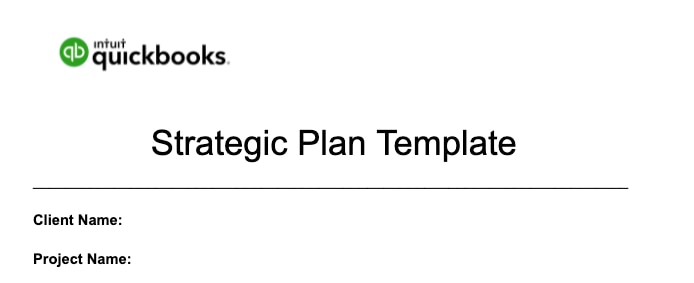The real purpose of an accountant is to help accomplish two overall objectives: improve financial results and attract capital. However, if you fail to plan, you plan to fail, so when tackling any goal make sure to use a strategic plan to ensure the best possible outcome.

How Accountants Help Clients with Strategic Planning
What Is A Strategic Plan?
As an advisor you can help your clients plan strategy for many things that will help business growth. You can help them plan strategy around:
- Taxes
- Cash flow
- Debt management
- Payroll
Strategic planning will help your clients communicate priorities, organize resources, strengthen operations and ensure that employees and other stakeholders are working towards common goals. It defines the path on how to get to specific outcomes/results and assesses/adjusts the organization’s methods. Effective strategic planning articulates not only where an organization is going and the actions needed to make progress, but also how it will know if it is successful.
A strategic plan includes:
- An executive summary
- A company description
- Mission, vision and value statements
- Strategic analysis of the internal and external environment
- SWOT analysis
- A description of your business goals and projects to achieve them
- A 12-month action plan that lists specific initiatives, who will carry them out, a timeline for doing so and key performance indicators to track progress
What are the Benefits of a Strategic Plan?
Doing strategic planning with clients will allow you to be proactive rather than reactive. As the accountant you can anticipate certain unfavourable scenarios – based on business performance– before they happen and take necessary precautions to avoid them.
A strategic plan provides management the roadmap to align the organization’s functional activities to achieve set goals. It guides management discussions and decision making in determining resource and budget requirements to accomplish set objectives — thus increasing operational efficiency.
A business may be booming one year and in debt the next. With constantly changing industries and world markets, organizations that lack a strong foundation, focus and foresight will have trouble riding the next wave.
5 Steps to the Process of Strategic Planning
Understanding your client, setting goals, preparing different pathways, analyzing risks, and implementation are all key steps in the process of strategic planning. Each step is an important pillar in ensuring success.
1. Understanding your client
This is the research step where you need to get a broad scope of your client and their records so you can see the full picture. Listen to the goals or targets your client wants to hit and analyze all your client’s financial records; what is their yearly cash flow, what are their expenses, where are they most profitable etc. By assessing a company’s/clients entire current situation you can make better predictions for what is realistic in the future, and will be able to offer a more specific/targeted approach on how to reach certain goals.
In this first step it is crucial you listen carefully to everything your client wants and needs. In order to get an even broader scope you can do research into your client’s industry to see what trends are coming up – see what has worked and what hasn’t – and maybe spark some new creative ideas. Basically the bigger the picture you see, the better.
2. Set goals
Insightful financial information helps create a crystal clear link in the client’s mind between what they set out to achieve (the financial goals and targets), what actually happened (actual results on the key metrics that drive performance), and what’s about to happen (a reliable financial forecast that provides the view through the financial lense of the business). So by clearly defining goals in a strategic plan, the client can quickly and easily see what they need to do, or change, in order to get the results they want.
3. Ensure you have multiple ways of reaching objectives
Once the goals have been set, look at the multiple ways you can achieve them. There are normally a few different ways you can solve a problem or attain a goal. So look at the research you collected in step one to determine all the different possible routes within the company you can take.
After taking a look at all the possible solutions to accomplishing your clients goals, grade them all numerically from most likely to succeed to least likely. This way you will have back up plans in case the first method didn’t work the way you thought it would.
Once your plan is in practice you can even start mixing and matching methods from your list – if that is the best solution.
4. Analyze risks
There is no reward without risk and most accounting strategies naturally come with risk. However, the implementation of strategies have greater odds of success when these potential risks have been anticipated and addressed.
Accountants are responsible for identifying and analyzing these risks, providing company managers with scenarios to explore and variables to monitor. Managers are responsible for making decisions based on this risk assessment information and making ongoing judgment calls as more information comes to light while the changes are being implemented.
5. Implementing the strategic plan
Accounting strategies must be implemented with the support of an entire team. In order to get employees, coworkers and company leaders on board with proposed changes, there must be a compelling case by presenting the financial information that management accountants have gathered and organized.
This process requires communication skills as well as useful and informative accounting figures that clearly elucidate the issue. For example, a manager lobbying to cut an under-performing company division can make his case most effectively by presenting current and historic sales figures.
Strategic plan template

Stay organized and on top of strategic planning for your accounting clients. This free template outlines the following:
- Mission statement
- Executive summary
- Accounting summary
- Market analysis summary
- Strategy and implementation
- Financial plan
Download a free strategic plan template here.
A crucial aspect in keeping a strategic plan organized and running efficiently is optimizing your finances. Having your books in check not only allows you to ensure your strategy is going according to plan but it gives you an accurate picture of where your business is at in the beginning so you are making decisions based on accurate information, and can monitor impact.
QuickBooks Online Accountant gives you direct access to your clients up to date financial data, so you always have a clear picture of where their business stands. Try it for free today!


